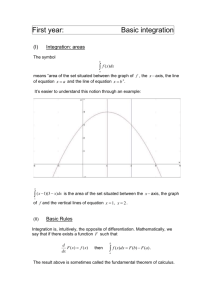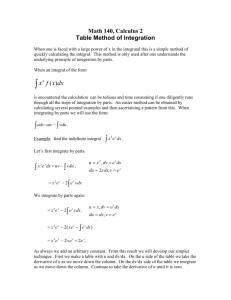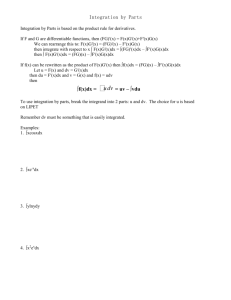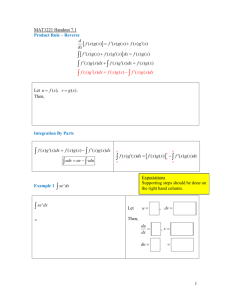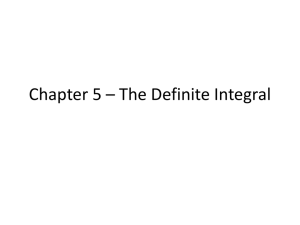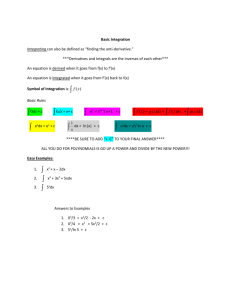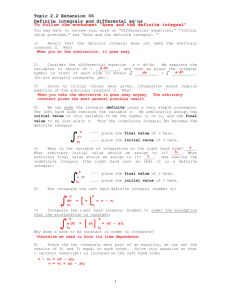Integrating with Absolute Value
advertisement
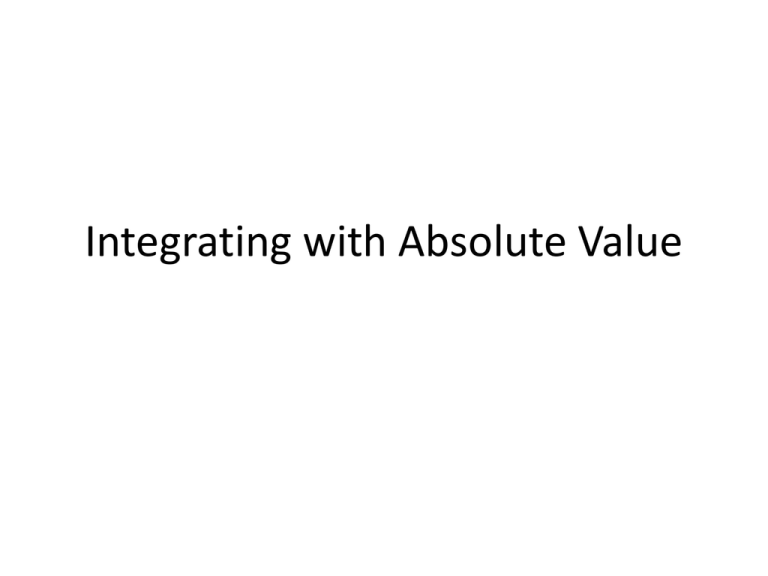
Integrating with Absolute Value • We will integrate these by using the (sum/difference) rules to separate the function into several different integrals. • When integrating a linear function with substitution it is often best to draw a rough sketch to help you decide where to break up the integral. This is especially important if we are finding the definite integral. • Remember what an absolute value function looks like, it takes every part of the function that is below the x-axis and reflects it back up above the x-axis. f ( x) x f ( x) | x | This part of the function is the opposite of the other part or –f(x). f ( x) x This part of the function f(x)=x is still the line y=x f ( x) x So an absolute value function is simply a piecewise, it is the positive part of f(x) and the other part is –f(x). x, when x 0 | x | x, when x 0 The cutoff points for x and –x is critical here, (0,0) we will always want to look for where the x-intercepts are. So we will integrate the following function by breaking it up into 2 parts. We need to break it up so we get rid of the absolute value bars. 4 4 0 4 | x | dx 4 xdx 0 xdx Now simply integrate both new integrals. Actually integrate both parts and evaluate. 0 4 4 0 xdx xdx If you have this graph could you also use the area formula for a triangle? Are these two triangles the same? • What about when the absolute value function is transformed? (moved away from (0,0)) We want to keep the same process in mind. Lets first work with a left/right transformation. 5 5 | x 3 | dx • What does this graph actually look like? Make a quick sketch • When you add something inside the |bars| then it moves the figure left, if you subtract something inside the bars it moves it right. • This changes the x-intercept from (0,0) and in this case puts it at (-3,0) which is critical for when we integrated the different parts. 3 5 5 ( x 3)dx ( x 3)dx 3 Find the definite integral 3 5 5 ( x 3)dx ( x 3)dx 3 • Now what if we want to move that function up or down? f ( x) | x 2 | 2 Find the area under the curve on the interval of [-4,3] 3 4 (| x 2 | 2)dx We will still break it up the absolute value part into parts, but also will deal with the +2 by itself. 3 4 3 | x 2 | dx 2dx 4 3 4 3 | x 2 | dx 2dx 4 • Now break up the absolute value part. 2 4 3 3 2 4 ( x 2)dx ( x 2)dx 2dx Integrate and evaluate the definite integral • Things get a little more tricky when the function becomes nonlinear. f ( x) x 3x 4 2 When we take the absolute value of this function, everything that is below the x-axis is reflected to the positive side. f ( x) | x 3x 4 | 2 The key points that determine what region is reflected over the x-axis are the x-intercepts, we will need to find those x-intercepts, because we will use them as our limits of integration for the above shaded part. (note that the shaded part is the opposite (negative) of what the original function was. Steps • Take the function and factor it to find the x-intercepts. In this case the x-intercepts are x=-4 and x=1. Those will be the limits of integration for the “bubbled part”. Break up the absolute value into the 3 parts and integrate. 2 5 | ( x 3x 4) | dx 2 4 5 ( x 3x 4)dx 2 + 1 4 ( x 2 3x 4)dx + 2 1 ( x 2 3x 4)dx Now integrate each part and add up 2 4 ( x 3x 4)dx + 4 5 5 | ( x2 3x 4) | dx 2 1 2 ( x 3x 4)dx + ( x 2 3x 4)dx 2 1
